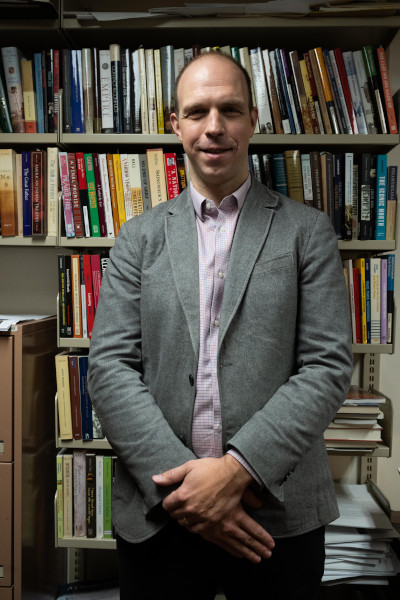PROFile: Colonization of ‘New Iceland’ displaced First Nations
Ryan Eyford, associate professor, Department of History
Photo by Keeley Braunstein-Black
Born in Eriksdale, Man., Eyford grew up near the Lake Manitoba Narrows and then later in the Winnipeg Beach and Gimli area.
“I went to high school in Gimli,” Eyford says. He first became interested in the topic of Icelandic immigration along the Lake Winnipeg area when studying as an undergraduate.
“I took a seminar with professor Jennifer Brown called Natives and Newcomers, as it was called back then. It was first suggested that I write about First Nations and Icelanders in the Manitoba Interlake,” Eyford says.
He studied Canada’s immigration policies to better understand how migrating Icelanders fit into Canadian colonization. Eyford says the timing and location of the Icelandic settlement was not coincidental.
“Why would there be so many people of Icelandic descent in the middle of North America? There’s no obvious reason. It’s a result of the fact that Icelandic immigration was just beginning as Canada was taking control of the North West and looking to recruit settlers,” Eyford says.
“The Canadian government chose to prioritize the choice of this immigrant group over the (Indigenous) people who already lived there,” Eyford says.
Part of the government’s immigration strategy involved expelling the Indigenous people living in the “New Iceland” colony. Instead, a greater tragedy transpired. The second group of Icelanders that arrived in 1876 contracted smallpox on their way to the colony, inadvertently infecting the unvaccinated First Nations living there.
“The majority of those (Indigenous) people died. The survivors left to join other adjacent First Nations,” Eyford says.
—
What do you do in your spare time?
“I spend time with my family. I also play recreational hockey.”
If you could travel to any point in history, where would you go?
“I think it would probably be the time period I actually study, which is the 1870s in Manitoba.”
What is one idea you hope your students take away from your classes?
“To understand the place that we live, you must understand Indigenous history.”
Published in Volume 77, Number 07 of The Uniter (October 27, 2022)







